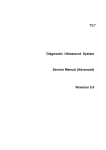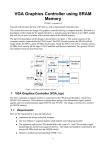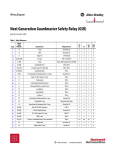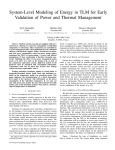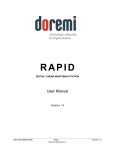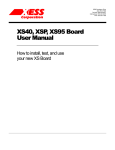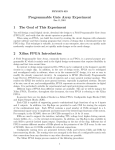Download A Simple VGA Interface for the PowerPC 403GCX Evaluation Board
Transcript
A Simple VGA Interface for the PowerPC 403GCX Evaluation Board Jonathan Jones, Undergraduate Department of Computer Science Texas A & M University Completed January 23, 2001 Table of Contents I. Abstract . . . . . . . . . . . . . . . . . . . . . . . . . . . . . . . . . . . . . . . . . . . . 3 II. Hardware Requirements . . . . . . . . . . . . . . . . . . . . . . . . . . . . . 3 Figure 1. Abstract wiring diagram . . . . . . . . . . . . . . . . . . . . 5 Table 1. Wire connections . . . . . . . . . . . . . . . . . . . . . . . . . . 6 Figure 2. Pinouts for connectors and components . . . . . . . . 6 III. Demonstrating the VGA Interface’s Functions . . . . . . . . . 7 Figure 3. Academic building in four shades of gray . . . . . . . 7 Figure 4. Three frames to be page-flipped . . . . . . . . . . . . . . 8 IV. Programming the VGA Interface . . . . . . . . . . . . . . . . . . . . . . 8 Table 2. 403GCX register settings . . . . . . . . . . . . . . . . . . . .9 Table 3. VGA interface memory map . . . . . . . . . . . . . . . . . 9 Table 4. Format of color registers . . . . . . . . . . . . . . . . . . . . 10 V. Implementation of the VGA Interface . . . . . . . . . . . . . . . . . 12 Figure 5. Diagram showing functional units, signals . . . . . 12 Figure 6. State diagram for BUSCTL . . . . . . . . . . . . . . . . . . 13 Figure 7. Timing diagram for memory write cycle . . . . . . . . 14 Figure 8. State diagram for MEMCTRL . . . . . . . . . . . . . . . . 15 Table 5. Descriptions of timing parameters . . . . . . . . . . . . 16 VI. Possible Future Projects . . . . . . . . . . . . . . . . . . . . . . . . . . . . . 17 VII. References . . . . . . . . . . . . . . . . . . . . . . . . . . . . . . . . . . . . . . . . . . 18 Appendices A. XS40 V1.1 documentation B. PPC 403 EVB expansion interface pinout C. 74ALS245 bus transceivers documentation D. 24.0 MHz clock oscillator documentation E. XStend V1.3 documentation F. VGA signal generation with the XS board G. VHDL source code for VGACORE module H. Documentation for SRAM module I. FPGA design schematics J. IBM 403GCX embedded controller manual K. Photographs 2 I. Abstract This report describes the author’s implementation of a VGA monitor interface for the PowerPC 403GCX evaluation board. Additional hardware used for the project essentially consists of a Xilinx[1] FPGA, a 32KB SRAM module, a few resistors (forming a simple DAC), and a VGA monitor connector. These components are all included on prototyping boards available from XESS Corp[2]. Because of the limited pinout of the FPGA chosen for the project, three 74245 bus transcievers are needed as well. A 24.0 MHz oscillator is used to clock the circuit. The VGA interface implemented allows the display of a 512 by 240 pixel image with four user-definable colors. It also includes a vertical offset register to facilitate hardware scrolling. Programs running on the 403GCX can update the registers and SRAM by using store instructions. II. Hardware Requirements The required hardware components, in addition to the PowerPC 403GCX evaluation board, are the following: 1. One XESS Corp. XS40 prototyping board. The implementation described herein uses a Version 1.1 board, which includes a Xilinx XC4010XL FPGA. Other versions of the XS40 with other FPGAs will work, but may require different jumper settings. Compare your board’s documentation with the Version 1.1 jumper settings listed below (in Part III ). If you don’t have an XS40 board, you can wire up your own FPGA, SRAM, power supply, and FPGA programming interface according to the XS40’s schematics. (The XS40’s other components are not used.) Complete Documentation for the XS40 V1.1 is included as Appendix A. 2. One XESS Corp. XStend board, which provides the VGA connector and DAC, and provides header pins to make it easier to wire wrap to the XS40’s pins. Versions 1.2 and above of the XS40 include the VGA connector and DAC onboard and make the XStend unnecessary for this application. This implementation was tested using the XStend V1.3; other versions may require different jumper settings. 3. One 24.0 MHz crystal oscillator clocks the circuit on the FPGA. Some versions of the XS40 include a 12.0 MHz oscillator, which 3 isn’t fast enough for this application. Others include a programmable oscillator which can’t be programmed to operate at 24.0 MHz. 4. Three 74245 octal bus transcievers. The specific part used for testing this implementation was the SN74ALS245AN from Texas Instruments. If you want to use a slower part, you may have to adjust the number of wait states in the BUSCTL state machine (Part IV). These transcievers isolate the 403GCX’s address and data buses from those of the SRAM. If you use an FPGA with a larger pinout, you can eliminate the need for these by connecting all bus lines directly to the FPGA, using separate pins for the SRAM’s buses and the 403GCX’s buses. 5. One 5V power supply for powering the bus transcievers. The XS40’s power supply does not appear capable of powering them while still enabling the oscillator to provide a clean and consistent signal. 6. A breadboard and wiring to connect everything together and to the PowerPC 403GCX evaluation board’s expansion interface. For testing, the following will also be needed: 7. Any VGA monitor. The signals output by the VGA interface are compatible with all VGA monitors. 8. The IBM RISCWatch debugger system. Installation and operation of this system is described in a previous report[3], and further documentation is available on IBM’s Web site[4]. It is basically a hardware/software interface to allow a PC to communicate directly with the PowerPC 403GCX through its JTAG testing interface. This allows the 403GCX’s I/O Configuration Register (IOCR) and Bank Registers (BRn) to be set, so the 403GCX will know how to access the VGA interface’s memory. Then RISCWatch can be used to actually load the data into display memory. Alternatively, you can write a program that sets the registers and fills the video RAM, and load this program using the evaluation board’s ROM monitor. 9. A PC connected via its parallel port to the XS40 board. The PC must have XSTOOLs software (available from XESS[2]) for programming the FPGA via the parallel port. For creating .BIT files (FPGA program images) you’ll need Xilinx Foundation Series software (from Xilinx[1]). The latter is not free, but it is not 4 necessary unless you want to modify the FPGA program. If not, just use the .BIT file accompanying this document. III. Assembly and Configuration Assembly consists of wiring the hardware components together. Configuration includes adding/removing shunts on the jumpers of the XS40 and XStend boards, and programming the FPGA. Pin assignments for the PowerPC 403GCX evaluation board’s expansion interface, for the 74245 bus transcievers, and for the 24.0 MHz oscillator are included in Appendices B, C, and D, respectively. Pin assignments for the XS40 (whose pins are exposed by the XStend) can be found in Appendix A. Figure 1 is a wiring diagram showing how the components are connected. Each line represents a set of connections, as detailed in Table 1. Figure 1. Abstract wiring diagram. 403GCX EVB Expansion Interface A B 742451 MX045 742452 C 5V power supply 742453 H D J E F + - G XStend Board J18 XS40 Board XS40’s parallel port interface to PC’s parallel port interface 9V power supply to VGA monitor + - 5 Exp Int A39 B39 A31 B31 C31 A32 B32 C32 742451 2 3 4 5 6 7 8 9 19 Exp Int B26 A26 A15 A40 B26 A E 742451 18 17 16 15 14 13 12 11 J18 3 4 5 78 79 82 83 84 68 J Table 1. Wire connections. B C Exp Int 742452 Exp Int 742453 A33 18 A9 18 B33 17 B9 17 C33 16 C9 16 A34 15 A10 15 B34 14 B10 14 C34 13 C10 13 A35 12 A11 12 B35 11 B11 11 F G 742452 J18 742453 J18 2 59 2 10 3 57 3 80 4 51 4 81 5 56 5 35 6 50 6 38 7 68 7 39 8 60 8 40 9 29 9 41 19 68 19 68 MX045 7 8 14 Exp Int C40 C28 742451 1 10 20 742452 1 10 20 742453 1 10 20 J18 52 J18 7 37 9 8 7 D H J18 52 14 2 Supply GND GND GND GND +5V GND GND +5V GND GND +5V GND Figure 2. Pinouts for connectors and components. PowerPC 403GCX EVB expansion interface connector C40 B40 A40 14 C1 B1 A1 20 8 74245 top view MX045 top view 10 J18 (oriented as in Figure 1) 1 1 7 21 22 11 1 84 64 63 42 43 6 For convenience, the pinouts for all the components and connectors are shown in Figure 2. Jumpers on the XS40 and XStend board are used to select certain options and disable various unneeded components. For versions 1.1 and 1.3, respectively, of the boards, the jumpers should be configured as follows. On the XStend board, move all DIP switches to the OFF/OPEN position, and remove shunts from all jumpers except J11. This will disable all the components on the XStend board except the VGA connector and its associated DAC. On the XS40 board, shunt jumpers J4, J5 (if present), J7 (across pins 1 and 2), and J11. Remove the shunts from jumpers J6 and J10. These settings specify, among other things, that the parallel port interface will be used to program the FPGA. See section 1.6 of Appendix A for more information about jumper settings of the XS40 V1.1 board. See Appendix E for information on jumper settings for the XStend V1.3. After doing all the above, all that remains is to program the FPGA with the VGA.BIT file. Do this by using the XSLOAD or GXSLOAD program from the XSTOOLs suite. An image should appear immediately on the screen after programming. (You may have to push the RESET button on the XStend board first.) IV. Demonstrating the VGA Interface’s Functions As a first demonstration, run the RISCWatch software and select “Command File” from the File menu. Then choose the file “SCREEN1.CMD” that accompanies this document. Execute the script in Normal Mode. The image in Figure 3 should be displayed on the VGA monitor. Figure 3. The Academic Building in four shades of gray. 7 This is a 512-by-240-pixel, four-color image. The color registers are loaded with white, black, and two intermediate shades of grey. Now load the command file “SCREEN2.CMD” in the same manner as before. This script demonstrates the palette shifting and page flipping capabilities of the VGA interface. It first loads three 512-by-85 pixel frames into VGA memory (Figure 4). It then sets the VGA interface’s HEIGHT register so that only the topmost 85 lines are displayed. To flip between the frames, it sets the VGA interface’s VOFFSET (vertical offset) register to the line number of the first line of each frame. By continually updating the VOFFSET register, simple animation effects are possible. The script also illustrates another simple animation method. By changing the appropriate color register (COLORA, COLORB, COLORC, or COLORD), you can change all the pixels on the display of that color. This allows changing the color of large areas of the screen much faster than would be possible by storing a new value in memory for each pixel. Combining these effects can achieve very annoying results, as the script shows. Figure 4. Three frames to be page-flipped. V. Programming the VGA Interface Preparing the VGA interface for use entails setting two of the 403GCX’s internal registers to inform the chip how to communicate with the VGA’s memory. These registers are the Input/Output 8 Configuration Register (IOCR) and Bank Register 3 (BR3). Table 2 shows values that were tested and verified to work, though they are probably not optimal. See Part VI for an explanation of these register settings. Table 2. 403GCX register settings. IOCR 0004C402 BR3 5010402E After these registers are set, the VGA interface is exposed to the programmer for access according to the memory map in Table 3. Data can be stored into the display memory and the VGA interface’s internal registers by standard memory write instructions. (It cannot be read, though; this memory is write-only.) Table 3. VGA Interface memory map (addresses in hex). Address(es) Size Field 75000000 – 75007FFF 32KB Display memory 75007800 – 75007FFF 2KB Invisible display memory 75008000 – 75008007 6B VGA interface’s internal registers 75008000 1B COLORA register 75008001 1B COLORB register 75008002 1B COLORC register 75008003 1B COLORD register 75008004 1B VOFFSET register 75008005 1B HEIGHT register 75008006 1B (unused) 75008007 1B (unused) The display memory is organized as follows. Each scan line is 512 pixels wide and occupies 128 bytes of memory. This means there are four pixels in each byte of display memory. And that means each pixel is represented by two bits, which can have four possible values. Pixels with values 0, 1, 2, and 3 are colored according to the values of color registers COLORA, COLORB, COLORC, and COLORD, respectively. The first scan line starts at address 75000000; the second starts 128 bytes later at 75000080; and so on. The VOFFSET register holds a value between 0 and 255 allowing the programmer to scroll the screen. A value of 0 is the default, nonscrolled situation. A value of 1 indicates that the VGA interface should start reading from address 75000080 instead of 75000000, effectively scrolling the screen by one scan line. 9 The HEIGHT register holds a value between 0 and 240 representing the number of scan lines to be displayed on the screen. A value of 240 is the default and causes the first 30 KB (240 scan lines) of display memory (starting from the address indicated by VOFFSET) to be visible. (The remaining 2 KB of display memory is “invisible.”) A value of 120, for example, causes the bottom half of the screen to be blank. Values greater than 240 can be used to add scan lines below the bottom of the usual display area. The HEIGHT and VOFFSET registers can be used together to implement page flipping, as described in Part IV. VOFFSET also helps in the imelementation of text scrolling. The new text can be drawn in the invisible display memory, then scrolled into view by incrementing VOFFSET. The format of the color registers (COLORA, COLORB, COLORC, COLORD) is shown in Table 4. bit 7 (MSB) field X Table 4. Format of color registers. 6 5 4 3 2 X Red1 Red0 Green1 Green0 1 Blue1 0 (LSB) Blue0 This shows that there are four levels of red, four levels of green, and four levels of blue available, for a total of 64 possible colors. This is determined by the limitations of the simple DAC available on the XStend board. The four color registers can be set independently (using byte-wide memory write instructions), so that four colors can be displayed on the screen at one time. See Part IV for an explanation of achieving animaton effects using palette shifting. VI. Implementation of the VGA interface Before beginning this section the reader should familiarize himself with Appendix F, which gives general information on the relevant VGA standard and describes an implementation of a VGA controller using the XS40. The VGACORE module specified therein is the basis, with modifications, for the VGACORE module used in the present application. The major changes applied to the original VGACORE are the following: 1. The original VGACORE only displays 256 pixels in each scan line. This isn’t suitable for displaying 80-column text. 512 pixels is 10 sufficient (with each text character six pixels wide, and space left over at the margins). However, this requires that the pixel clock speed be doubled. The original VGACORE used the XS40’s onboard 12.0 MHz clock; the new version will require an external 24.0 MHz clock. 2. In the original VGACORE the colors are hard-wired. The new version makes use of four color registers (COLORA, COLORB, COLORC, COLORD; see Part V) to allow the colors to be changed in software. 3. A VOFFSET register was added to allow hardware scrolling to be controlled by software (see Part V). 4. A HEIGHT register was added to allow the number of scan lines in the display to be controlled by software (see Part V). 5. Since the clock speed is doubled, the SRAM is no longer fast enough to yield correct output in the span of a single clock cycle. Therefore the new VGACORE uses pipelining to allow the SRAM three clock cycles to drive its outputs before they are sampled. This change was effected by editing the process labeled I. The conditional if hcnt(1 downto 0)="00" then was changed to if hcnt(1 downto 0)="11" then Since the SRAM’s address bus is driven when hcnt=”00”, that gives three clock cycles before its outputs are sampled. Of course, this also required tweaking the hsyncb and blank signals to account for the pipelining delay. 6. The VGACORE module is continually reading from SRAM while the electron beams sweep across the screen. Then there is an idle period in which the beams are moved back across the screen to the beginning of the next scan line. Then after all the scan lines have been displayed, there is a much longer idle period while the beams are moved back to the top of the screen. These idle periods are utilized by the new VGACORE, via its memreq signal, to yield control of the SRAM to allow the 403GCX to access it. VGACORE drops memreq to allow the BUSCTL state machine to give control of the 403GCX access to the local address and data buses. 11 The VHDL source code for the new VGACORE is shown in Appendix G. To understand how the VGACORE interacts with the rest of the system, consult Figure 5. While painting the pixels on the screen, VGACORE drives the local address bus and reads the local data bus. When VGACORE yields control of the buses, BUSCTL is enabled. BUSCTL then disables the SRAM’s outputs, enables the bus transcievers (thereby connecting the 403GCX to the local address and data buses), and enables the MEMCTRL unit. MEMCTRL can then communicate with the 403GCX, through the three handshaking signals shown, to oversee memory writes from the 403GCX to the SRAM and internal registers. When VGACORE is ready to paint the next scan line, it disables BUSCTL, which tri-states the bus transcievers and enables the SRAM’s data outputs. MEMCTRL postpones any pending memory accesses until the next time it is READY CHIP SELECT 403GCX WRITE BYTE VGA Monitor ADDRESS BUS DATA BUS RGB SYNC Bus Transcievers ENABLE VGACORE LOCAL ADDRESS BUS LOCAL DATA BUS ENABLE BUSCTL ENABLE ENABLE WRITE ENABLE MEMCTRL REGISTERS SRAM MEMORY MODULE REGISTER VALUES FPGA Figure 5. Diagram showing functional units, data paths, and control signals. 12 enabled by BUSCTL. VGACORE uses its MEMREQ output to enable BUSCTL. Examine Figure 6, which shows the state diagram for BUSCTL, a finite state machine. BUSCTL waits in its “VGA” state until VGACORE deasserts MEMREQ. Then it disables the SRAM’s data outputs, and waits in its ZWt1 state for the SRAM’s data outputs to reach high impedance. Then BUSCTL enables the external bus transcievers to connect the 403GCX to the local address and data buses. After waiting in BWt for the buses to be driven, it asserts MC_ENABLE, which gives control of the buses to the MEMCTRL module. When VGACORE needs access to memory again, it asserts MEMREQ. BUSCTL immediately deasserts MC_ENABLE, disables the bus transcievers (thus isolating the 403GCX from the local buses), and enables the SRAM’s data outputs. The cycle repeats. BU SCTL //diagram AC TION S Sreg0 R ESET MC _EN ABLE C LOC K BU F_OEN MEMREQ SR AM_OEN Wt RESET=’1’ SR AM_OEN <= ’1’; BU F _OEN <= ’1’; MC_EN ABLE <= ’0’; W t := W t + 1; VGA /0/ M EM REQ = ’0’ SR AM_OEN <= ’1’; W t := 0; Z W t1 /1/ W t := W t + 1; Wt >= 5 BU F_OEN <= ’0’; W t := 0; BW t /2/ Wt >= 5 MC _EN ABLE <= ’1’; Wt >= 5 Wt >= 5 SW t /5/ W t := W t + 1; VGA: Z W t1: BW t: PPC : Z W t2: SW t: Z W t2 /4/ SR AM_OEN <= ’0’; W t := 0; W t := W t + 1; M EM REQ = ’1’ MC _EN ABLE <= ’0’; BUF _OEN <= ’1’; W t := 0; PPC /3/ W ait while VGACOR E is controlling m em ory . W ait f or the buses to be tri-stated. W ait f or external buf f ers to driv e the buses. Allow PPC to control m em ory until VGAC OR E raises MEMR EQ. W ait f or the buses to be tri-stated. W ait f or address/data buses to be driv en by VGAC OR E/SR AM. Figure 6. State diagram for BUSCTL. This is a Mealy machine. Transition conditions are italicized. Transition actions are boxed. A box attached directly to a state is an action that occurs each time the state is entered. Wt is a variable. 13 The MEMCTRL module is responsible for processing the memory writes from the 403GCX to the SRAM and to the internal registers. To see how the memory write cycle works, look at Figure 7. To the left of the timing diagram is a brief schematic showing the interconnections and direction of each signal. Figure 7. Timing diagram for PPC → SRAM write cycle. PPC FPGA CSPPC WBE READY ADDR DATA ADDRLOCAL DATALOCAL G OE CSSRAM WE XCVER SRAM tSDXE tXELZ tXP tCSWB tADCP tWBWE tWP tWBR tADCS tCSWH tWR tRCWH tCWRL tADH tWHAD Before memory can be accessed by the PPC 403GCX, the BUSCTL module must connect the 403GCX’s address and data buses to those of the SRAM. That means it must deactivate the SRAM’s data outputs (using the OE¯ signal) and enable the bus transceivers (with G¯). This causes ADDRLOCAL and DATALOCAL to be driven by the bus transceivers. BUSCTL has entered its PPC state and raised its MC_ENABLE signal, giving the PPC 403GCX access to the SRAM, controlled by the MEMCTRL module. When the PPC 403GCX initiates a memory write, it first drives ADDR and DATA, and then CS¯PPC (“chip select”) is dropped to indicate that the memory address being written to is within the VGA memory’s address range. Finally WBE¯ (“write byte enable”) is dropped to 14 indicate that the address and data buses are ready to be sampled, and the memory write can begin as soon as the VGA is ready. As soon as the address on ADDR has propagated through the transceivers to ADDRLOCAL, the CS SRAM signal is either raised or dropped by the MEMORY module. If the address is associated with one of the VGA’s internal registers, CS SRAM is driven high; if the address is in the range associated with the SRAM, CS SRAM is driven low. When MEMCTRL senses that the PPC 403GCX has initiated a write cycle, it drops the SRAM’s WE signal to write the data on DATALOCALinto the address on ADDRLOCAL. After the appropriate write pulse duration (tWP) the memory access is complete, and the MEMORY module can raise READY to allow the PPC 403GCX to complete the cycle. The handshaking is completed when the PPC 403GCX raises its CS PPC and WBE PPC signals. After a certain hold time (tADH), a new memory write cycle can begin. MEMCTRL is implemented as the simple Mealy FSM shown in Fig. 8. R ESET MEMC TR L MC _EN ABLE //diagram AC TION S PPC_W BN SR AM_W EN PPC_CSN R EAD Y C LOC K Sreg0 Wt RESET = ’1’ SR AM_W EN <= ’1’; READ Y <= ’0’; W t := W t + 1; Idle /0/ M C_ENABLE = ’1’ and PPC_CSN = ’0’ and PPC_WBN = ’0’ W t := 0; Buf W t /1/ M C_ENABLE = ’0’ (postpone) Wt >= 2 SR AM_W EN <= ’0’; W t := 0; M C_ENABLE = ’0’ SR AM_W EN <= ’1’; (postpone) PPC_WBN = ’1’ R EADY <= ’0’; Idle: W ait f or control of m em ory and PPC write request. Buf W t: W ait f or address and data buses to be set up by external buf f ers. W rite: Process request; if interrupted (MC _ENABLE = ’0’), then postpone the m em ory write until MC _EN ABLE = ’1’. Ack: Assert R EAD Y until PPC _W BN = ’1’. W t := W t + 1; W rite /2/ Wt >= 3 SRAM_W EN <= ’1’; R EAD Y <= ’1’; (com pleted) Ack /3/ Figure 8. The MEMCTRL module. 15 Of note is MEMCTRL’s ability to postpone the current memory transcation until it regains access to SRAM if, at any time before the access is complete, the MC_ENABLE signal is dropped by BUSCTL. This means that if a memory write is in progress when the VGACORE is ready to draw the next scan line, that memory write can be postponed until the VGACORE yields control of SRAM. MEMCTRL only asserts READY when and if the memory access actually completes. The timing intervals labeled in Figure 7 are explained in Table 5. tSDXE tXELZ tXP tADCP tCSWB tADCS tWBWE Table 5. Descriptions of timing parameters shown in Fig. 7. Time from SRAM disable to transceivers enable. This interval must be at least the time it takes for SRAM to tri-state its data outputs (TOHZ in Appendix H). It is controlled by the number of clock cycles that BUSCTL stays in its ZWt1 state. Time from transceivers enable until transceiver outputs are driven. This interval is a property of the transceivers (tPZH and tPZL in Appendix C). Time for values to propagate through the bus transceivers. This is a property of the transceivers (tPLH and tPHL in Appendix C). Time after ADDR and DATA are driven before CS PPC is dropped. This is determined by the setting of the CSN bit of the 403GCX’s BR3 register (see Appendix J). It is set to 0 in this application. Time after CS PPC is dropped before WBE is dropped. This interval is determined by the setting of the WBN bit of the 403GCX’s BR3 register (see Appendix J). It is set to 1 in this application, so that WBE is dropped one 403GCX clock cycle after ADDR and DATA are driven. Time after ADDRLOCAL is set up before CS SRAM is set. This interval is a small propagation delay from one of the FPGA’s input pins, through an AND gate, and back out through an output pin (see schematic for MEMORY module in Appendix I). It’s negligible, as long as tCSWH is large enough. Time after WBE is dropped before WE is dropped. This is controlled by the number of clock cycles that MEMCTRL spends in its BufWt state. If tXP < tADCP + tCSWB, then this parameter can be 0. 16 tWP Write pulse width. The SRAM requires that ADDRLOCAL, DATALOCAL, and WE held for a certain period (TWP in Appendix H) in order for the memory write to be completed succcessfully. The length of this interval is controlled by setting the number of clock cycles that the MEMCTRL module spends in its Write state. tWR Time after WE is raised before READY is raised. This is zero, but it could be increased by adding wait states to MEMCTRL between its Wait and Ack states. tCSWH Time after CS SRAM is set before WE goes high. The lower bound is a parameter of the SRAM (TCW in Appendix H). Since tADCS is so small, this requirement is easily met. tWBR Time from WBE low until READY high. In the 403GCX’s devicedpaced transfer mode (controlled by the RE bit of the BR3 register; see Appendix J) the 403GCX automatically inserts wait states during this interval. The PTD bit of the 403GCX’s IOCR register (Appendix J) must be set to 1 so that the number of wait states is unlimited. tWHAD DATALOCAL hold time after WE goes high. There is no lower bound set by the SRAM module (see TDH in Appendix H). tADH ADDR and DATA hold time after CS PPC and WBE are raised. This is controlled by the TH field of the 403GCX’s BR3 register (see Appendix J). TH was set to 7 for testing this application. tRCWH Time after READY is raised before CS PPC and WBE are raised. This is controlled by the TWT field of the 403GCX’s BR3 register (see Appendix J). According to TWT, the 403GCX will wait a certain number of clock cycles before it samples the READY signal. TWT was set to 10 for testing this application. tCWRL Time after CS PPC and WBE are raised before READY is deasserted. This is controlled by the number of clock cycles the MEMCTRL module spends in ts Ack state. Currently READY is deasserted on the next rising clock edge after CS PPC and WBE are sampled high. The top-level project schematic and the schematic for the MEMORY module are shown in Appendix I. VII. Possible Future Projects This work could be easily expanded upon in several obvious ways. The XC4010XL has ample extra room for additional logic: Number of CLBs: 101 out of 400 25% CLB Flip Flops: 96 CLB Latches: 0 4 input LUTs: 136 3 input LUTs: 32 (20 used as route-throughs) Number of bonded IOBs: 42 out of 65 64% IOB Flops: 0 17 IOB Latches: 0 Number of BUFGLSs: 1 out of 8 Total equivalent gate count for design: 1803 12% ♦ The VGA interface’s resolution and color depth could be enhanced by increasing the frequency of the dot clock, increasing the amount of SRAM available, and modifying the VGACORE module. ♦ The page-flipping and scrolling facilities (see Parts IV and V) could be improved by adding HOFFSET and WIDTH registers. This would enable horizontal scrolling and page-flipping. ♦ Hardware support for text display could be added. Separate memory areas for the font and the display map could be user configurable. Text scrolling could be accomplished in hardware. ♦ Additional screen modes could be added. Screen refresh rates, resolutions, and color depths could be software-selectable. ♦ Other peripherals could be connected to the 403GCX’s expansion interface to work in concert with the VGA interface. The information compiled in the Appendices and illuminated in the text of this document should be very helpful in these pursuits. References [1] Xilinx Corporation: http://www.xilinx.com [2] XESS Corporation: http://www.xess.com [3] “Developing Applications for the IBM PPC403GCX Evaluation Board” was a CPSC 483 project at Texas A&M in the Spring of 2000. The final report is available here: http://chef.cs.tamu.edu/past-projects/00a/G6/final_report.doc [4] The home page for RISCWatch: http://www.chips.ibm.com/products/powerpc/tools/riscwatc.html 18 Appendix A This Appendix contains documentation for Version 1.1 of XESS Corporation’s XS40 prototyping board. This document was originally downloaded from here: http://www.xess.com/manuals/xs40-manual-v1_1.pdf Appendix B This Appendix contains the pinout for the PowerPC 403GCX evaluation board’s expansion interface. It was excertped from Section 5.4 of the IBM PowerPC 403 Evaluation Board Kit User’s Manual. The User’s Manual was originally found here: http://www.chips.ibm.com/products/powerpc/evalkits/403ev_um.pdf Appendix C This Appendix contains documentation for the Texas Instruments SN74ALS245AN octal bus transciever. It was originally located here: http://www-s.ti.com/sc/psheets/sdas226a/sdas226a.pdf Appendix D This Appendix cointains documentation for the CTS Reeves MX045 24.0 MHz clock oscillator. It was originally located here: http://www.ctscorp.com/reeves/clocks/047.pdf Appendix E This Appendix contains documentation for Version 1.3 of XESS Corporation’s XStend board. This document was originally located here: http://www.xess.com/manuals/xst-manual-v1_3.pdf Appendix F This document is an explanation of how to implement a simple VGA controller using the XS40/XStend. It was originally found here: http://www.xess.com/appnotes/vga.pdf Appendix G This Appendix includes the VHDL source code for the modified VGACORE module used in this application. It was originally based on the VGACORE module described in Appendix F. library IEEE; use IEEE.std_logic_1164.all; use IEEE.std_logic_unsigned.all; entity vgacore is port ( reset: in std_logic; -- reset clock: in std_logic; -- VGA dot clock colorA: in std_logic_vector(5 downto 0); colorB: in std_logic_vector(5 downto 0); colorC: in std_logic_vector(5 downto 0); colorD: in std_logic_vector(5 downto 0); memreq: out std_logic; -- request/yield control of SRAM height: in std_logic_vector(7 downto 0); voffset: in std_logic_vector(7 downto 0); hsyncb: buffer std_logic; -- horizontal (line) sync vsyncb: out std_logic; -- vertical (frame) sync rgb: out std_logic_vector(5 downto 0); -- red,green,blue colors addr: out std_logic_vector(14 downto 0); -- address into video RAM data: in std_logic_vector(7 downto 0) -- data from video RAM ); end vgacore; architecture vgacore_arch of vgacore is signal hcnt: std_logic_vector(9 downto 0); signal vcnt: std_logic_vector(9 downto 0); signal pixrg: std_logic_vector(7 downto 0); signal blank: std_logic; signal pblank: std_logic; signal begin ----- horizontal pixel counter vertical line counter byte-wide register for 4 pixels video blanking signal -- pipelined video blanking A: process(clock,reset) begin -- reset asynchronously clears pixel counter if reset=’1’ then hcnt <= "0000000000"; -- horiz. pixel counter increments on rising edge of dot clock elsif (clock’event and clock=’1’) then -- horiz. pixel counter rolls-over after 761 pixels if hcnt<760 then hcnt <= hcnt + 1; else hcnt <= "0000000000"; end if; end if; end process; B: process(hsyncb,reset) begin -- reset asynchronously clears line counter if reset=’1’ then vcnt <= "0000000000"; -- vert. line counter increments after every horiz. line elsif (hsyncb’event and hsyncb=’1’) then -- vert. line counter rolls-over after 528 lines if vcnt<527 then vcnt <= vcnt + 1; else vcnt <= "0000000000"; end if; end if; end process; C: process(clock,reset) begin -- reset asynchronously sets horizontal sync to inactive if reset=’1’ then hsyncb <= ’1’; -- horizontal sync is recomputed on the rising edge of every dot clock elsif (clock’event and clock=’1’) then -- horiz. sync is low in this interval to signal start of a new line if (hcnt>=584 and hcnt<676) then hsyncb <= ’0’; else hsyncb <= ’1’; end if; end if; end process; D: process(hsyncb,reset) begin -- reset asynchronously sets vertical sync to inactive if reset=’1’ then vsyncb <= ’1’; -- vertical sync is recomputed at the end of every line of pixels elsif (hsyncb’event and hsyncb=’1’) then -- vert. sync is low in this interval to signal start of a new frame if (vcnt>=490 and vcnt<492) then vsyncb <= ’0’; else vsyncb <= ’1’; end if; end if; end process; -- blank video outside of visible region: (0,0) -> (513,479) E: blank <= ’1’ when (hcnt>=515 or hcnt<=2 or vcnt>=(height & ’0’)) else ’0’; memreq <= ’1’ when ((vcnt<=(height & ’0’) or vcnt>=526) and (hcnt <= 515 or hcnt >= 755)) else ’0’; --memreq <= ’1’; -- store the blanking signal for use in the next pipeline stage F: process(clock,reset) begin if reset=’1’ then pblank <= ’0’; elsif (clock’event and clock=’1’) then pblank <= blank; end if; end process; -----------H: The video RAM address is built by appending bits 8-2 of the horizontal pixel counter to bits 8-1 of the vertical line counter. (We don’t have enough memory to display 512 x 480, so we’re displaying 512 x 240 and ignoring bit 0 of the vertical line counter.) Example: When displaying the pixel at (x,y) = (511,239) the horizontal pixel counter is "111111111", and the vertical line counter is "11101111x". Concatenating: vertical[8:1] = 11101111 + horizontal[8:2] = 1111111 = 111011111111111 So this application uses 30720 bytes of RAM. addr <= (vcnt(8 downto 1) & hcnt(8 downto 2)) + (voffset & "0000000"); I: process(clock,reset) begin -- clear the pixel register on reset if reset=’1’ then pixrg <= "00000000"; -- pixel clock controls changes in pixel register elsif (clock’event and clock=’1’) then -- the pixel register is loaded with the contents of the video -- RAM location when the lower two bits of the horiz. counter -- are both zero. The active pixel is in the lower two bits -- of the pixel register. For the next 3 clocks, the pixel -- register is right-shifted by two bits to bring the other -- pixels in the register into the active position. if hcnt(1 downto 0)="11" then pixrg <= data; -- load 4 pixels from RAM else pixrg <= "00" & pixrg(7 downto 2); -- right-shift pixel register end if; end if; end process; -- the color mapper translates each 2-bit pixel into a 6-bit -- color value. When the video signal is blanked, the color -- is forced to zero (black). J: process(clock,reset) begin -- blank the video on reset if reset=’1’ then rgb <= "000000"; -- update the color outputs on every dot clock elsif (clock’event and clock=’1’) then -- map the pixel to a color if the video is not blanked if pblank=’0’ then case pixrg(1 downto 0) is when "00" => rgb <= colorA; when "01" => rgb <= colorB; when "10" => rgb <= colorC; when others => rgb <= colorD; end case; -- otherwise, output black if the video is blanked else rgb <= "000000"; -- black end if; end if; end process; end vgacore_arch; Appendix H This Appendix contains documentation for the SRAM module included on the XS40 board V1.1: Winbond’s W24257AK-15 SRAM. This document was originally located here: http://www.winbond.com/sheet/257a-12.pdf Appendix I This Appendix includes schematics for the FPGA program used in this application. On the next page the top-level schematic is shown. The page after contains the schematic for the MEMORY module. Appendix J This Appendix contains an explanation of the PowerPC 403GCX’s IOCR and BR3 registers. It was excerpted from Section 12.8 of the IBM PPC403GCX Embedded Controller User’s Manual. The User’s Manual was originally located here: http://www.chips.ibm.com/products/powerpc/chips/gcx_um.pdf Appendix K Here are a couple of photographs of the finished project. The first shows the VGA interface in action, displaying an image on a VGA monitor. The second shows a close-up view of the wiring.








































